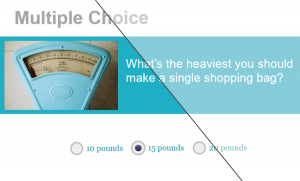Style Guides for E-Learning Courses
When I’m working with a new client and ask for the company’s style guide, I often get a blank look. Until I ask that question, people are often using their own standards, rather than a true “style”–so we create one with them!
Here are the things you may want to know if you don’t already have and use a style guide for your e-learning courses.
What is a style guide?
A style guide is a document generally put together by company representatives (such as owners, managers, the marketing department, or the training department) to define how writers should handle certain writing, grammar, and formatting issues. Style guides can include anything that defines the “style” of your course (or any other written document, for that matter).
Why should we have a style guide?
Having a style guide can help writers and editors consistently use the company standards. It allows all documents published to use the same style and ultimately give a unified company image. The style guide can be used to give direction for anything–from word choice to what font should be used in printed documents and beyond.
Ultimately, having a style guide saves time! I was recently working with a team of editors and one of the editors missed the style guide memo (literally) stating where to find the guide. Fortunately, it only took her a few screens before she called me because she realized all of the bulleted lists in the course were “wrong.” I can only imagine the time we would have wasted on this project if she had edited all of the screens to her standards rather than to the correct style guide.
Where do I find it?
If you don’t know where your company’s style guide is or if they even have one, ask around. Depending on your company, it may be on the intranet, with Marketing, in Human Resources, etc. You may even find that a particular published and popular style guide is “the standard.” Some common style guides are the AP Stylebook, The Chicago Manual of Style, and The Gregg Reference Manual.
If we don’t have one, how do I create one?
I’ve created a sample writing style guide template you can use to see some of the common things you might want to consider. The goal of this template is to help you address the issues that are the most common questions to writers and identify the areas that are truly a matter of style and preference (such as whether PM, P.M., or p.m. is correct). You’ll probably want to make changes based on your organization.
There are several right ways to write many things. The purpose of a style guide is to help you maintain consistency in your grammar and writing style from screen to screen and from course to course.

 Previous Post
Previous Post




Thank you so much for this article. I always appreciate the nuggets of wisdom when I open your emails!
Thanks for your comment, Becky! By the way, if you ever have a topic you’d like to hear our thoughts on, please feel free to let me know. We’re always open to blog ideas.
I love your writing style guide and will be sure to spread the word. Very important for teams. Thank you.
Kinda goes with well with my visual style guide. What do you think? http://theelearningcoach.com/media/graphics/visual-style-guide-for-elearning/
Hello, Connie, thanks for your post. Yes, I do think our suggestions work VERY well together.
I just want to add in that for many groups, this is most useful for the people who are the “design experts” for the ultimate medium of the content. For example, as an instructional designer, I have a lot of SMEs who actually “write” the content, but in my experience it is difficult to expect them to follow such specific standards if they are, say, from a technical background instead of a training, communications, or english background. This is true even in cases where I have provided the document with the formatting already done and instructions to “fill in the blanks”; more than likely, something will still come back a bit wrong, haha.
As a best practice I do always provide these resources and mention them in every project for those SMEs who may be receptive to it, but at the end of the day I’m happy if I just get the content, and then I make sure it is edited correctly.
So, a style guide is useful in my case for the design/development team to make sure each instructional designer is making a product consistent with the others, and to manage expectations of your stakeholders for what the content will end up looking like and if that will take you more time based on their source content, etc.